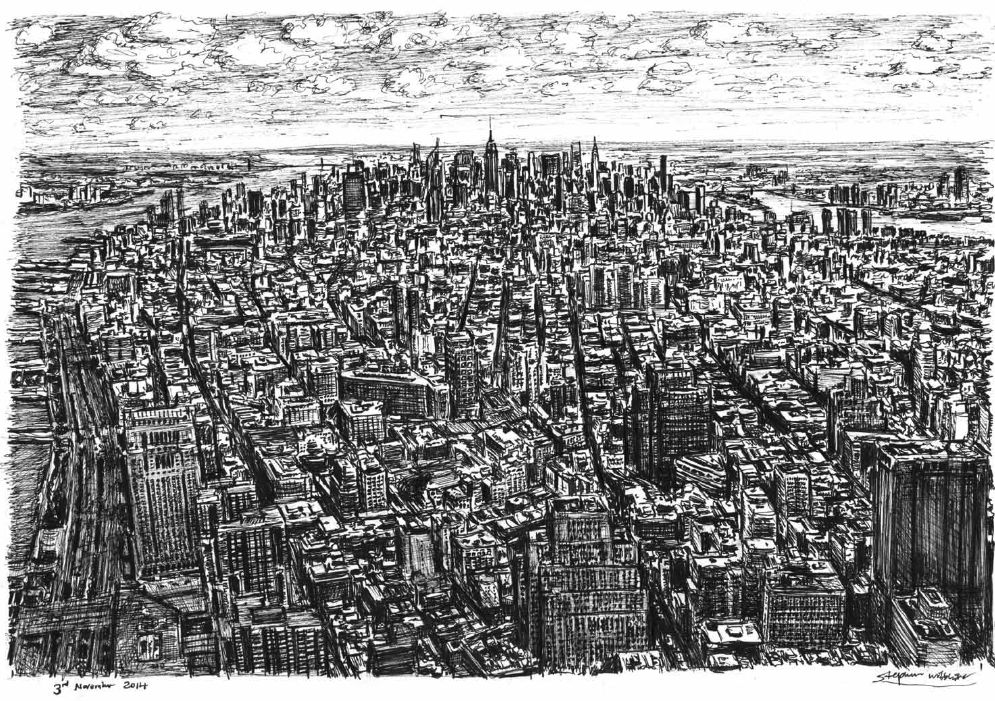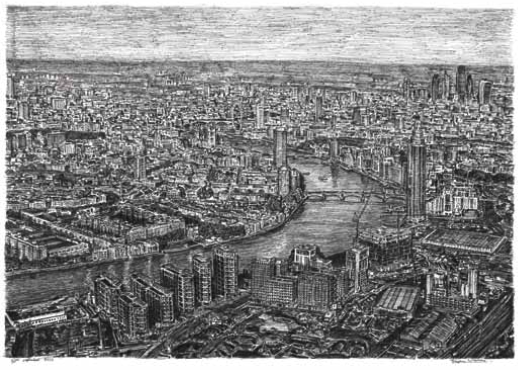The Delight’s in the Details
Stephen Wiltshire’s pen-and-ink drawings of major cities are feats of meticulous draftmenship, remarkable memory and unstoppable drive.
by Rebecca Dvorak
A city is more than its buildings. For London artist Stephen Wiltshire, however, the fervent energy of the skyline or the looming peak of a landmark building captures the heart and soul of a metropolis. Wiltshire has earned acclaim for his finely detailed pen-and-ink drawings that portray the minutiae of cityscapes around the world. Drawing quickly and often without referencing his subject matter, he’s able to capture hundreds of landmarks, streets and buildings. Remarkably, he creates many of his pieces from memory with exacting perfection. The artist sketches on the street, from the top of a skyscraper or, in the case of his larger panoramas, after a helicopter ride over the city.
Child Artist
Born in London in 1974, Wiltshire created his first panorama, a 61/2-foot wide depiction of Liverpool, at the age of 13. He had turned to drawing as a child when he found it difficult to communicate through more traditional means. Unable to speak until he was 5, he connected with the world through drawing, and it became his passion. He was never without his pen and paper.
When Wiltshire was 8, his school began entering his art into competitions. One of his pieces caught the eye of former British prime minister Edward Heath. Heath purchased Wiltshire’s drawing of Salisbury Cathedral, which rocketed the child artist onto the BBC television program The Foolish Wise Ones in 1987, where he was introduced by former president of the Royal Academy of Arts Sir Hugh Casson as “the best child artist in Britain.”
After this appearance, Wiltshire’s career as an artist and his reputation worldwide grew with astonishing speed. He published Drawings, a volume of sketches from early in his career that included a preface by Casson, and soon enrolled in the City & Guilds of London Arts School. There he experimented with different media but would always come back to the familiar pencils and pen and ink of his childhood as his media of choice.
Wiltshire traces the trajectory of his work as a timeline for his life. “As I have developed as a person, my art- work has developed with me,” he says. “As I have gotten older, wiser and more mature, so has my work. I would like to think that my draftsmanship has gotten better in time, due to experience. My art is my life history.”
Inspiring People and Places
Like-minded artists constantly inspire Wiltshire. In particular, he names American photorealist Richard Estes’ reflective, clean and geometric paintings of cities as having a huge impact on his work. He also admires the work of London-based international photographer, Henry Reichhold, whose images of cities clearly influence Wilshire’s aesthetic.
In 1988, Wiltshire visited New York City for the first time and quickly added this metropolis to his list of favorite places. “To me, it’s like my second home away from London,” he says. “Both cities are great: eccentric, noisy and energetic with bright lights and so much going on.” He was particularly captivated by the bustling atmosphere, beautiful skyscrapers and interesting architecture. Of all the buildings in New York, he’s partial to the Empire State Building. Not only has he created numerous drawings of this edifice, but he also exhibited his work there in 1994. In every city he visits, he’s drawn to the high-rise buildings “that elevate and stand tall with elegant beauty,” as he says, and his sketches and drawings from his trips to New York are among those of which he’s most proud.
Wiltshire’s initial trip to that city sparked a love of travel that paired perfectly with his passion for drawing urban landscapes. Endlessly fascinated by the way cities develop, he likes to stay up to date on changes both big and small in the metropolises he explores. Most of all, he relishes the details and pays careful attention to the little things during his worldwide visits. Wiltshire aspires to draw as many major cities as he can and, in doing so, to capture “the heart and soul of every person who lives in those cities.”
In 2005, Wiltshire was commissioned to create large panoramic drawings of 10 world cities. He began with Tokyo, traveling to Japan at the age of 31 to embark on a project that would hearken back to his drawing of Liverpool as a 13-year-old. He created a 33-foot long canvas depicting the Tokyo skyline in exquisite detail —still his longest panorama to date. Since then he has drawn giant panoramas of Rome, Hong Kong, Frankfurt, Madrid, Dubai, Jerusalem, London, Sydney, Shanghai, Brisbane and New York.

Feats of Memory
Typically, for these large-scale panoramas, Wiltshire will take a short helicopter ride or head to the top of a high-rise building, observing and taking pictures on his iPhone. He’ll then create a schedule that designates when he’ll work on particular sections of the panorama. “I set a plan for myself,” he says, “and work out an itinerary for each day and study enough for that scheduled day.”
One of the most staggering elements of Wiltshire’s work is the amount of visual information he’s able to recall from memory as he draws. “I think about the windows, the detail and the perspective,” he says. “The rest is pretty easy for me. When I’m not as familiar with a city, it can take me longer to memorize, which adds a lot of pressure because I want to succeed and get it right.”
Once he has memorized the planned section for that day, he gets to work and relies solely on the reference materials locked in his brain. He starts by creating a pencil sketch of the designated area. When he’s happy with that, he uses Staedtler pens—his decades- long tool of choice—to add the details.
In some cities, special drawing events have been organized to allow an audience to observe Wiltshire in action as he creates a panorama. The artist’s obvious talent and his acumen for remembering detail attract large crowds. At a recent event in Singapore, Wiltshire welcomed 150,000 visitors over a five-day period, setting attendance records for the venue. In fact, in cities around the world, Wiltshire often attracts spontaneous crowds wherever he stops to draw.
Once the formidable sprint of the multi-day drawing process is over, Wiltshire enjoys his favorite part of the process: the finish. He savors the moment when he can walk backward, observe his work and see that it’s finally completed. “Then, I know I did my best and was able to keep pace and keep going,” says Wiltshire. “I don’t see it as a struggle. I see it as artistry in progress.”

Behind the Drive
Wiltshire’s incredible drive and work ethic underpin everything he does. “I have worked very hard, and I am also very passionate about what I do,” he says, pointing out that he draws every day, whether it’s for a specific piece or just for his own pleasure. “Do the best you can and never stop,” he says, and he holds himself to that highest of standards.
Wiltshire’s services to the art world were formally recognized in 2006 when he was made a Member of the Order of the British Empire, a prestigious honor. Subsequently, he and his family opened a permanent art gallery for his work in the Royal Opera Arcade, in London. He has been featured in numerous advertising campaigns and continues to be commissioned for pieces displayed in notable buildings and at highly publicized events. He has published three books (in addition to Drawings) and won several notable awards for his work, including the McCarton Foundation Genius of Autism Award.
Yes—Wiltshire is autistic. It was his early passion for drawing that enabled him to connect with others. He sees his work as “a language we can all understand, no matter where we are from.” When he isn’t traveling, he works in his studio which, although it’s private, offers a wait list for the opportunity to visit and watch the artist at work. “I get to meet lots of people as an artist,” he says. “When I win an award, I value the opportunity to go on stage and thank everyone who believes in me.”
None of Wiltshire’s achievements has made him complacent; he continues to travel extensively and draw prolifically. “I feel very proud of myself,” he says. “Every day is a challenge; life is a challenge. I just take every day as a good day. I try to work hard and be happy.”
That’s what it all comes down to: Drawing makes Wiltshire happy, and it’s a tool that allows him to connect with cities across the world and the people who live within them.
Rebecca Dvorak, of New York City, is an arts writer and editor.
Visit stephen Wiltshire’s Website at stephenWiltshire.co.uk.
A version of this story appeared in the June 2019 edition of Artists Magazine, and it includes more of Wiltshire’s work.
